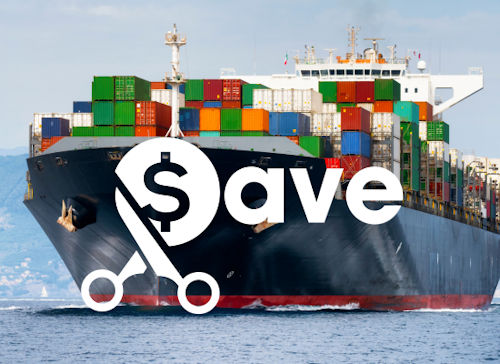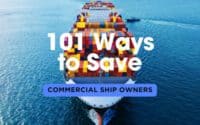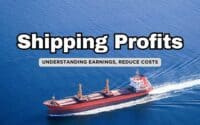25 Cost Cutting Strategies for Fleet Owners

In today’s challenging economic climate, the maritime sector is under constant pressure to enhance operational efficiency and reduce costs. Ship and fleet owners are exploring a wide array of innovative products, technologies, and strategies to maintain profitability while ensuring compliance with environmental regulations. From fuel efficiency technologies to advanced materials and digitalization, the following 25 cost-cutting strategies represent some of the most effective ways to achieve significant savings and operational improvements in the maritime industry.
* Please send feedback/suggestions to editor @ shipuniverse.com
1. Fuel Efficiency Technologies
Air Lubrication Systems
- How It Works: Creates a layer of air bubbles along the hull to reduce friction.
- Cost Savings: Can reduce fuel consumption by up to 10-15%.
Hull Coatings
- How It Works: Special coatings such as copper, biocide, silicone to reduce drag and prevent marine growth.
- Cost Savings: Improved fuel efficiency and lower maintenance costs.
Energy-Saving Devices (ESDs)
- How It Works: Includes devices like propeller boss cap fins and rudder bulbs that optimize water flow.
- Cost Savings: Fuel savings of up to 5%.
2. Operational Strategies
Slow Steaming
- How It Works: Reduces speed to lower fuel consumption.
- Cost Savings: Can save up to 30% in fuel costs, depending on the reduction in speed.
Route Optimization
- How It Works: Uses advanced software to find the most fuel-efficient routes.
- Cost Savings: Reduced fuel consumption and emissions.
Just-In-Time Arrival
- How It Works: Adjusts ship speed to ensure arrival at the optimal time, minimizing port congestion and waiting time.
- Cost Savings: Reduced fuel consumption and port fees.
3. Digitalization and Automation
Predictive Maintenance
- How It Works: Uses sensors and data analytics to predict equipment failures before they occur.
- Cost Savings: Reduces unplanned downtime and maintenance costs.
Autonomous and Remote-Controlled Operations
- How It Works: Utilizes automation for navigation and cargo handling.
- Cost Savings: Reduces crew costs and human error.
4. Alternative Fuels and Energy Sources
LNG (Liquefied Natural Gas)
- How It Works: A cleaner alternative to traditional marine fuels.
- Cost Savings: Lower fuel costs and compliance with emission regulations.
Hybrid and Electric Propulsion
- How It Works: Combines traditional engines with battery power.
- Cost Savings: Fuel savings and reduced emissions.
5. Energy Management Systems
Integrated Energy Management
- How It Works: Systems that monitor and optimize energy use on board.
- Cost Savings: Improved energy efficiency and reduced operational costs.
6. Retrofitting and Upgrades
Scrubbers
- How It Works: Removes sulfur oxides from exhaust gases to meet emission regulations.
- Cost Savings: Allows the use of cheaper high-sulfur fuel while meeting environmental regulations.
Ballast Water Treatment Systems
- How It Works: Treats ballast water to prevent the spread of invasive species.
- Cost Savings: Compliance with regulations and avoidance of fines.
7. Financial Strategies
Leasing and Financing Options
- How It Works: Flexible financing solutions to spread the cost of new technologies and retrofits.
- Cost Savings: Improved cash flow management and reduced upfront costs.
Tax Incentives and Subsidies
- How It Works: Taking advantage of government incentives for green technologies.
- Cost Savings: Reduced capital expenditure and operational costs.
8. Crew Management and Training
Optimized Crew Scheduling
- How It Works: Uses software to optimize crew schedules and rotations.
- Cost Savings: Reduces overtime and improves crew efficiency.
Advanced Training Programs
- How It Works: Utilizes simulators and e-learning platforms to enhance crew skills.
- Cost Savings: Minimizes accidents and improves operational efficiency.
9. Supply Chain Optimization
Just-In-Time Inventory
- How It Works: Coordinates with suppliers to receive parts and materials as needed.
- Cost Savings: Reduces inventory holding costs and minimizes waste.
Vendor Consolidation
- How It Works: Reduces the number of suppliers to streamline procurement.
- Cost Savings: Leverages bulk purchasing for better pricing and terms.
10. Retrofit Solutions
Waste Heat Recovery Systems
- How It Works: Captures and reuses waste heat from the engine for other purposes on the ship.
- Cost Savings: Improves overall energy efficiency and reduces fuel consumption.
High-Efficiency Lighting
- How It Works: Replaces traditional lighting with LED or other energy-efficient options.
- Cost Savings: Lower energy consumption and reduced maintenance costs.
11. Insurance and Risk Management
Performance-Based Insurance
- How It Works: Offers lower premiums based on the ship’s operational performance and safety record.
- Cost Savings: Reduced insurance costs through better safety and operational practices.
Risk Assessment Tools
- How It Works: Uses advanced analytics to assess and mitigate risks.
- Cost Savings: Reduces the likelihood of costly accidents and claims.
12. Sustainable Practices
Green Certifications
- How It Works: Achieves certifications like ISO 14001 for environmental management.
- Cost Savings: Access to preferential port fees and incentives for environmentally friendly operations.
Carbon Offsetting Programs
- How It Works: Invests in projects that offset carbon emissions.
- Cost Savings: Meets regulatory requirements and enhances brand reputation, potentially leading to new business opportunities.
13. Optimized Port Operations
Port Call Optimization
- How It Works: Uses digital platforms to optimize port call schedules and reduce waiting times.
- Cost Savings: Minimizes demurrage charges and fuel consumption while in port.
Efficient Cargo Handling
- How It Works: Implements advanced cargo handling equipment and techniques to speed up loading and unloading.
- Cost Savings: Reduces port stay duration and associated costs.
14. Enhanced Communication Systems
Advanced Satellite Communication
- How It Works: Utilizes high-speed satellite communication for real-time data exchange and monitoring.
- Cost Savings: Improves operational efficiency and reduces downtime through better coordination.
Integrated Bridge Systems
- How It Works: Combines various navigational and communication tools into a single interface.
- Cost Savings: Enhances navigational accuracy and reduces the risk of accidents.
15. Lifecycle Management
Condition-Based Monitoring
- How It Works: Continuously monitors the condition of critical ship components to schedule maintenance only when needed.
- Cost Savings: Avoids unnecessary maintenance and extends the lifespan of equipment.
Asset Management Software
- How It Works: Tracks the lifecycle of all assets on the ship, from acquisition to disposal.
- Cost Savings: Optimizes asset utilization and reduces replacement costs.
16. Collaborative Platforms
Maritime Digital Platforms
- How It Works: Uses platforms like Blockchain for transparent and efficient documentation and transactions.
- Cost Savings: Reduces paperwork, errors, and fraud, leading to smoother operations and lower administrative costs.
Shared Services
- How It Works: Collaborates with other shipping companies to share services like bunkering, repairs, and logistics.
- Cost Savings: Achieves economies of scale and better pricing through collective bargaining.
17. Enhanced Security Measures
Cybersecurity Solutions
- How It Works: Implements advanced cybersecurity measures to protect against cyber threats.
- Cost Savings: Prevents costly data breaches and operational disruptions.
Anti-Piracy Measures
- How It Works: Utilizes physical and technological measures to protect against piracy.
- Cost Savings: Reduces insurance premiums and the risk of ransom payments or cargo loss.
18. Advanced Materials and Construction
Lightweight Materials
- How It Works: Uses advanced composite materials to reduce the weight of the vessel.
- Cost Savings: Improves fuel efficiency and reduces operational costs.
Modular Construction
- How It Works: Builds ships in modular sections to streamline construction and repair processes.
- Cost Savings: Reduces construction time and costs, and allows for easier upgrades and repairs.
19. Renewable Energy Integration
Solar Panels
- How It Works: Installs solar panels on the ship to generate electricity from renewable sources.
- Cost Savings: Reduces fuel consumption for auxiliary power and lowers operational costs.
Wind-Assisted Propulsion
- How It Works: Utilizes technologies like rotor sails or kite sails to harness wind power.
- Cost Savings: Decreases fuel consumption and reduces greenhouse gas emissions.
20. Water Management Systems
Fresh Water Generation
- How It Works: Uses desalination systems to produce fresh water from seawater.
- Cost Savings: Reduces the need to carry large quantities of fresh water, improving fuel efficiency.
Water Recycling Systems
- How It Works: Implements systems to recycle greywater and blackwater for non-potable uses.
- Cost Savings: Lowers water consumption and reduces the need for fresh water resupply.
21. Efficient Engine Technologies
Dual-Fuel Engines
- How It Works: Uses engines capable of running on both traditional fuels and alternative fuels like LNG.
- Cost Savings: Provides flexibility in fuel choices, potentially reducing fuel costs and meeting emission regulations.
Engine Performance Monitoring
- How It Works: Continuously monitors engine performance to optimize fuel consumption and maintenance schedules.
- Cost Savings: Improves fuel efficiency and extends engine life, reducing repair and replacement costs.
22. Regulatory Compliance Solutions
Emission Control Systems
- How It Works: Installs systems like scrubbers and selective catalytic reduction (SCR) to meet emission regulations.
- Cost Savings: Avoids fines and penalties for non-compliance and can allow the use of cheaper fuels.
Compliance Management Software
- How It Works: Uses software to track and manage compliance with international maritime regulations.
- Cost Savings: Reduces administrative burden and ensures timely compliance, avoiding costly fines.
23. Waste Management Systems
Advanced Waste Treatment
- How It Works: Uses onboard waste treatment systems to process and reduce waste volume.
- Cost Savings: Reduces disposal costs and ensures compliance with environmental regulations.
Waste-to-Energy Solutions
- How It Works: Converts waste into energy through incineration or other technologies.
- Cost Savings: Generates energy from waste, reducing fuel consumption and disposal costs.
24. Cargo Optimization
Load Optimization Software
- How It Works: Utilizes software to optimize cargo load and distribution for better balance and fuel efficiency.
- Cost Savings: Enhances fuel efficiency by optimizing weight distribution and reducing drag.
Real-Time Cargo Tracking
- How It Works: Implements IoT devices and sensors to monitor cargo conditions and location in real time.
- Cost Savings: Reduces losses from damaged goods, improves logistics planning, and enhances overall efficiency.
25. Collaborative Research and Development
Industry Partnerships
- How It Works: Partners with research institutions and other maritime companies to develop new technologies and solutions.
- Cost Savings: Shares R&D costs, accelerates innovation, and gains access to cutting-edge technologies.
Pilot Programs
- How It Works: Participates in pilot programs to test new technologies and operational strategies in real-world conditions.
- Cost Savings: Identifies the most effective solutions before large-scale implementation, reducing the risk of costly failures.
Adopting any of these 25 cost-cutting strategies can significantly improve the bottom line for ship and fleet owners. By leveraging advanced technologies, optimizing operations, and embracing sustainable practices, maritime companies can reduce expenses, enhance efficiency, and remain competitive in a rapidly evolving industry. These innovations not only offer immediate financial benefits but also position businesses for long-term success in an increasingly regulated and environmentally conscious market. As the maritime sector continues to navigate economic challenges, implementing these strategies will be crucial for sustaining growth and achieving operational excellence.

Do you have a Maritime Product or Service that may be of interest to Shipowners? Tell us about it here!
Do you have feedback or insights? Please reach out to editor @ shipuniverse.com



